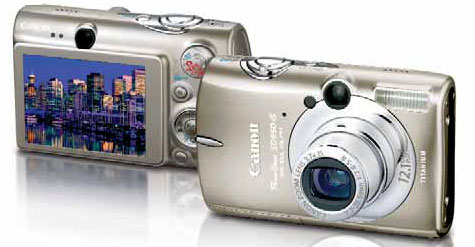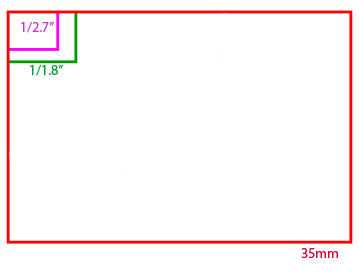The Digital Sensor: A Guide to Understanding Digital Cameras
by Wesley Fink on April 21, 2008 1:00 AM EST- Posted in
- Digital Camera
A few years ago, all digital cameras were "point and shoot" and they were very expensive compared to film cameras. Digital prices dropped rather quickly as digital sensor resolution continued to increase. Soon enough digital "point-and-shoot" cameras were available at every price point from a basic snapshot to the more serious models geared at the prosumer market.
At the dawn of the consumer digital SLR in 1999, a 2.7MP (megapixel) DSLR with an APS C sensor was considered an incredible buy at $5000. Tremendous growth in market share and the falling prices of DSLR cameras in the years since have created new buying options for those shopping for an upgrade to an existing camera or even a first camera. This has been particularly true in the last couple of years. All of the old reasons to own a point and shoot instead - with lower cost leading the way - have fallen by the wayside as the DSLR has continued to evolve and become both very price competitive with P&S and much easier to use.
However, many new DSLR buyers are walking into a brave new world with blinders on. The first question everyone should ask is why should you buy a DSLR instead of a point and shoot? Are there real technical advantages to DSLRs? After all the ads for point-and-shoots are hyping the same range of sensor resolutions that you will find in digital SLR cameras, so why buy a DSLR? The answer to that question is what really prompted this article.

Yes, you can buy 10MP and 12MP point-and-shoot cameras - the same megapixel range as current mainstream DLSR cameras - but they cannot possibly produce the same image quality over the same wide range of shooting conditions as a digital SLR. The reason why is simple physics, as the point-and-shoot sensors are much smaller than sensors in a DSLR. In fact, that is also the very reason why point-and-shoot digital cameras were the only choices in the market for a few years.
The early sensors were much lower megapixel resolutions, far too low to begin to compete with film photography. Photo hobbyists saw few advantages in moving to a low resolution system since the reason they used an SLR was high image quality. It wasn't until resolutions reached the 2-4MP range that there was any interest in a digital SLR.

The early sensors were also very small, developed primarily for video usage. The 1/2.7" compact sensor is 5.3x4.0mm and the larger 1/1.8" is 7.2x5.3mm - compared to 35mm at 24x36mm. These typical compact sensors are just a tiny fraction the size of 35mm sensors, and these sensors were among the largest available in P&S digital cameras. Some tried to develop proprietary systems based on a smaller sensor size with more compact lenses, but nothing caught on in the industry. The cost of early sensors was also astronomical, making the early digital SLR cameras only useful for production, high volume photography where the cost could be justified.
Finally, early digital development saw sensor resolution and size in constant evolution. With sensor size changing with each new generation, it was much easier to design a point-and-shoot camera around each new sensor generation using a dedicated and non-interchangeable lens. Until sensor size stabilized, a digital SLR that used either existing 35mm lens systems or a new "standard size" was not practical.










72 Comments
View All Comments
Johnmcl7 - Monday, April 21, 2008 - link
On page 4:"The Foveon sensor falls between 4/4 and the Canon 1.6 in size and has a 1.7X lens multiplier."
I assume this should read '4/3'
Obvious question is what about Fuji? While I realise they re-use Nikon bodies and lenses, the discussion about Bater and Foveon makes no mention of Fuji's sensor. While it is more conventional than the Foveon, it's not just a bog standard bayer sensor and while Fuji are a minor player, so are Sigma.
For those who are not familiar with Fuji's design, they use two photodiodes at every point one larger and one smaller with the two combined to produce a single pixel in the output image. The idea is that these pair of pixels can capture more extended dynamic range than a standard bayer sensor of the same size. The latest version of this sensor is in the Fuji S5 Pro however it's limited to just 6MP although I can't remember if they still produce 12MP files from this. The S5 itself is basically a Fuji version of the very good Nikon D200 body although Nikon have of course moved on with the very impressive D300.
John
Wesley Fink - Monday, April 21, 2008 - link
Yes, it should have read 4/3 and the reference is corrected. The Fuji S3 was one of my favorite Nikon bodies and the dynamic range was certainly impressive in the studio.We did not mean to slight Fuji, but as one Nikon-mount body with a sensor that hasn't been updated in several years (the S3 and S5 sensors are the same as I understand it) we decided not to include the Fuji since there have been no sensor updates in quite a while.
Johnmcl7 - Monday, April 21, 2008 - link
"We did not mean to slight Fuji, but as one Nikon-mount body with a sensor that hasn't been updated in several years (the S3 and S5 sensors are the same as I understand it) we decided not to include the Fuji since there have been no sensor updates in quite a while. "I can't say I really agree there, given the article more focuses on concept in parts I think the S5 sensor is still relevent as it's something slightly different to the bayer sensor. The article refers to only Bayer and Foveon which implies there is nothing else, I think for completeness even if you don't go into any detail it's still worth mentioning Fuji are doing something else.
Also the S3 and S5 sensor are not the same, while they have the same amount of pixels it appears there's been some slight improvements although clearly not much. To be far to Fuji though, the Foveon sensor hasn't really come on much either - it's gone up very slightly in resolution with some small other changes but that's it pretty much. If the Foveon sensor had been just mentioned in passing I could definitely understand leaving Fuji with a similar mention but generally Fuji and Sigma are considered in the same boat as doing something a bit different although arguably with the Nikon body and mount Fuji have had more success.
John
melgross - Tuesday, April 22, 2008 - link
I never saw an advantage to their designs. I can't see what purpose having a smaller photo site on the sensor would do. It just has more noise, and less dynamic range than the larger sensor. I've read their papers on the subject, and they don't seem to have made a good case for it. Somehow, I think they understand that now.Johnmcl7 - Thursday, April 24, 2008 - link
"I never saw an advantage to their designs. I can't see what purpose having a smaller photo site on the sensor would do. It just has more noise, and less dynamic range than the larger sensor. I've read their papers on the subject, and they don't seem to have made a good case for it. Somehow, I think they understand that now."Are you referring to Fuji? If so, your information is incorrect - the last measurement I saw put the S5's sensor at slightly more dynamic range than the 35mm sensor in the Nikon D3. Their real problem at the moment seems to be resolution as well as having the older D200 based body.
John
strikeback03 - Tuesday, April 22, 2008 - link
I think Sigma (and Foveon) would be better off if Sigma could license a major player's mount, like Kodak did with the SLR/n and SLR/c. There are plenty of people who would like to have the sensor for the situations where it excels, but have no interest in a whole Sigma SA mount setup.pinto4402 - Monday, April 21, 2008 - link
I've been reading Anandtech for over 8 years now. I was a bit skeptical about your doing articles on digital cameras; however, this article put my reservations to rest. Very nicely done.I see why it makes sense for Anandtech to write about digital cameras. The nexus between computer tech and camera tech are very obvious if you've been following the trends. I'm a professional portrait photographer. In the last few years, it has become virtually impossible to remain in business unless you have a firm grasp on the latest camera tech as well as computer tech. I spend as much time on my computer as I do behind the camera. The camera has become a computer accessory (or vice versa). Many old timers who are hanging on to film are slowly being forced out. I'm somewhat of an old timer myself because I learned about photography when it was cool to have a darkroom, but I embraced digital equipment early.
Your graphs make it very easy to explain to people why their P&S (piece of s***) cameras are simply not adequate for serious portraiture. The MP count is marketing crap. As you demonstrated, it's the physical size of the sensor that matters.
Looking forward to part II of the series. Also, do you have any solid info on the introduction of 5D Mk II?
bjacobson - Tuesday, April 22, 2008 - link
"The MP count is marketing crap."Mostly. If you're willing to do some post processing yourself, the higher MP will enable you to decrease the IQ gap between the higher end DSLR and the ho-hum consumer camera. For this reason, since I wanted something compact and didn't really need a lot of optical zoom, I chose the Canon SD1100IS. 8MP, and while you begin to get noise at ISO400, more at ISO800, and tons at ISO1600, using a non-linear digital filter should correct most of that without blurring the image much (if at all).
strikeback03 - Wednesday, April 23, 2008 - link
Problem is that the camera has already blurred away lots of your detail at ISO 400 and up.http://www.dpreview.com/reviews/canonsd1100is/page...">http://www.dpreview.com/reviews/canonsd1100is/page...
Too bad there is no option to reduce/turn off the in-camera NR, for those of us who own a better program for it already.
Wesley Fink - Monday, April 21, 2008 - link
I wish I did have definitive info about the 5D Mark II launch, but the best info I have is this fall at Photokina. Rumors pop up every month that the new 5D will be here in a few weeks - and the last rumor was a definite April 22, which is tomorrow. Rumors are just that - rumors.